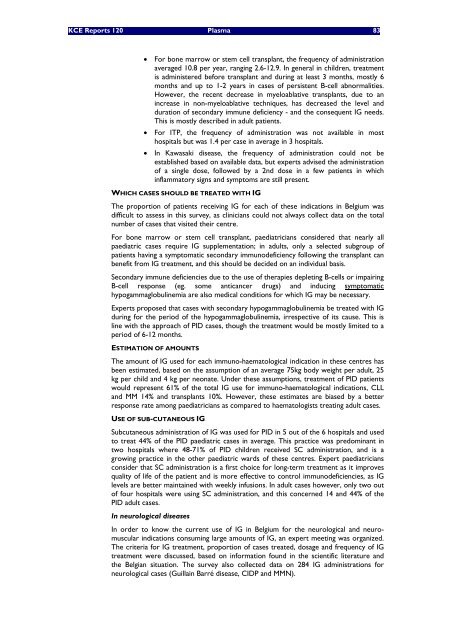The report is available in English with a French summary - KCE
The report is available in English with a French summary - KCE
The report is available in English with a French summary - KCE
You also want an ePaper? Increase the reach of your titles
YUMPU automatically turns print PDFs into web optimized ePapers that Google loves.
<strong>KCE</strong> Reports 120 Plasma 83<br />
• For bone marrow or stem cell transplant, the frequency of adm<strong>in</strong><strong>is</strong>tration<br />
averaged 10.8 per year, rang<strong>in</strong>g 2.6-12.9. In general <strong>in</strong> children, treatment<br />
<strong>is</strong> adm<strong>in</strong><strong>is</strong>tered before transplant and dur<strong>in</strong>g at least 3 months, mostly 6<br />
months and up to 1-2 years <strong>in</strong> cases of pers<strong>is</strong>tent B-cell abnormalities.<br />
However, the recent decrease <strong>in</strong> myeloablative transplants, due to an<br />
<strong>in</strong>crease <strong>in</strong> non-myeloablative techniques, has decreased the level and<br />
duration of secondary immune deficiency - and the consequent IG needs.<br />
Th<strong>is</strong> <strong>is</strong> mostly described <strong>in</strong> adult patients.<br />
• For ITP, the frequency of adm<strong>in</strong><strong>is</strong>tration was not <strong>available</strong> <strong>in</strong> most<br />
hospitals but was 1.4 per case <strong>in</strong> average <strong>in</strong> 3 hospitals.<br />
• In Kawasaki d<strong>is</strong>ease, the frequency of adm<strong>in</strong><strong>is</strong>tration could not be<br />
establ<strong>is</strong>hed based on <strong>available</strong> data, but experts adv<strong>is</strong>ed the adm<strong>in</strong><strong>is</strong>tration<br />
of a s<strong>in</strong>gle dose, followed by a 2nd dose <strong>in</strong> a few patients <strong>in</strong> which<br />
<strong>in</strong>flammatory signs and symptoms are still present.<br />
WHICH CASES SHOULD BE TREATED WITH IG<br />
<strong>The</strong> proportion of patients receiv<strong>in</strong>g IG for each of these <strong>in</strong>dications <strong>in</strong> Belgium was<br />
difficult to assess <strong>in</strong> th<strong>is</strong> survey, as cl<strong>in</strong>icians could not always collect data on the total<br />
number of cases that v<strong>is</strong>ited their centre.<br />
For bone marrow or stem cell transplant, paediatricians considered that nearly all<br />
paediatric cases require IG supplementation; <strong>in</strong> adults, only a selected subgroup of<br />
patients hav<strong>in</strong>g a symptomatic secondary immunodeficiency follow<strong>in</strong>g the transplant can<br />
benefit from IG treatment, and th<strong>is</strong> should be decided on an <strong>in</strong>dividual bas<strong>is</strong>.<br />
Secondary immune deficiencies due to the use of therapies deplet<strong>in</strong>g B-cells or impair<strong>in</strong>g<br />
B-cell response (eg. some anticancer drugs) and <strong>in</strong>duc<strong>in</strong>g symptomatic<br />
hypogammaglobul<strong>in</strong>emia are also medical conditions for which IG may be necessary.<br />
Experts proposed that cases <strong>with</strong> secondary hypogammaglobul<strong>in</strong>emia be treated <strong>with</strong> IG<br />
dur<strong>in</strong>g for the period of the hypogammaglobul<strong>in</strong>emia, irrespective of its cause. Th<strong>is</strong> <strong>is</strong><br />
l<strong>in</strong>e <strong>with</strong> the approach of PID cases, though the treatment would be mostly limited to a<br />
period of 6-12 months.<br />
ESTIMATION OF AMOUNTS<br />
<strong>The</strong> amount of IG used for each immuno-haematological <strong>in</strong>dication <strong>in</strong> these centres has<br />
been estimated, based on the assumption of an average 75kg body weight per adult, 25<br />
kg per child and 4 kg per neonate. Under these assumptions, treatment of PID patients<br />
would represent 61% of the total IG use for immuno-haematological <strong>in</strong>dications, CLL<br />
and MM 14% and transplants 10%. However, these estimates are biased by a better<br />
response rate among paediatricians as compared to haematolog<strong>is</strong>ts treat<strong>in</strong>g adult cases.<br />
USE OF SUB-CUTANEOUS IG<br />
Subcutaneous adm<strong>in</strong><strong>is</strong>tration of IG was used for PID <strong>in</strong> 5 out of the 6 hospitals and used<br />
to treat 44% of the PID paediatric cases <strong>in</strong> average. Th<strong>is</strong> practice was predom<strong>in</strong>ant <strong>in</strong><br />
two hospitals where 48-71% of PID children received SC adm<strong>in</strong><strong>is</strong>tration, and <strong>is</strong> a<br />
grow<strong>in</strong>g practice <strong>in</strong> the other paediatric wards of these centres. Expert paediatricians<br />
consider that SC adm<strong>in</strong><strong>is</strong>tration <strong>is</strong> a first choice for long-term treatment as it improves<br />
quality of life of the patient and <strong>is</strong> more effective to control immunodeficiencies, as IG<br />
levels are better ma<strong>in</strong>ta<strong>in</strong>ed <strong>with</strong> weekly <strong>in</strong>fusions. In adult cases however, only two out<br />
of four hospitals were us<strong>in</strong>g SC adm<strong>in</strong><strong>is</strong>tration, and th<strong>is</strong> concerned 14 and 44% of the<br />
PID adult cases.<br />
In neurological d<strong>is</strong>eases<br />
In order to know the current use of IG <strong>in</strong> Belgium for the neurological and neuromuscular<br />
<strong>in</strong>dications consum<strong>in</strong>g large amounts of IG, an expert meet<strong>in</strong>g was organized.<br />
<strong>The</strong> criteria for IG treatment, proportion of cases treated, dosage and frequency of IG<br />
treatment were d<strong>is</strong>cussed, based on <strong>in</strong>formation found <strong>in</strong> the scientific literature and<br />
the Belgian situation. <strong>The</strong> survey also collected data on 284 IG adm<strong>in</strong><strong>is</strong>trations for<br />
neurological cases (Guilla<strong>in</strong> Barré d<strong>is</strong>ease, CIDP and MMN).

















